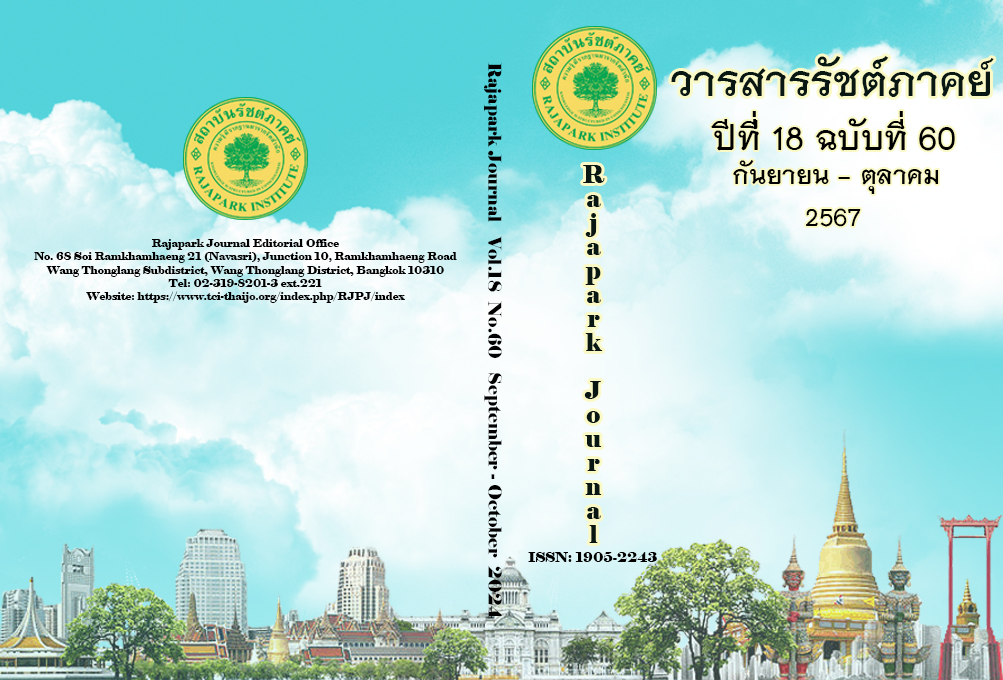Selection of Alternative Energy Projects to Implement in Agriculture Cooperatives Using AHP Technique
Main Article Content
Abstract
This research aimed to analyze the criteria and alternative energy projects appropriate for use in agricultural cooperatives. There are 30 samples composed of 10 samples from professionals, 5 samples each from middle, large, and extra-large-sized cooperatives that are suitable for implementing alternative energy projects or already using alternative energy in the cooperative, and 5 samples from non-cooperative farmers. The instrument for collecting data was the AHP process. Data will be analyzed using descriptive statistics and content analysis. The research results were found as follows; 1) Solar energy has the largest importance value percentages overall at 49.00 followed by biogas, wind energy, and hydro energy at 18.63, 17.07, and 15.30 respectively 2) Payback period provides the largest importance value percentages overall at 22.20 following by resources and geometry, sustainable operations, quality of work and project investment at 21.61, 21.52, 18.60 and 16.06 respectively 3) The research suggests that solar energy is the most suitable energy projects for use in agricultural cooperatives, and the payback period is the most important criterion for considering the selection of alternative energy projects.
Article Details

This work is licensed under a Creative Commons Attribution-NonCommercial-NoDerivatives 4.0 International License.
Views and opinions appearing in the Journal it is the responsibility of the author of the article, and does not constitute the view and responsibility of the editorial team.
References
Amatawanich, N., & Viroonraj, B. (2017). The new model of indicators for considering renewable energy projects. Veridian E-Journal, Silpakorn University, 10(2), 2602-2617.
Assawatangsastian, A., Banjerdrith, S., & Laohanant, S. (2017). The worthiness of investment in alternative energy in Thailand. Journal of MCU Social Science Review, 6(2), 335-345. https://so03.tci-thaijo.org/index.php/jssr/article/view/240660
Ayers, J., Melchert, G., & Piwowar, J. (2014). The impact of renewable energy cooperatives on the social resilience of their communities. Blekinge Institute of Technology, Karlskrona, Sweden. https://bth.divaportal.org/smash/get/diva2:830813/FULLTEXT01.pdf
Chiradeja, P. (2010). The development of renewable energy for generating electricity in Thailand. Srinakharinwirot University Journal of Sciences and Technology, 2(4), 10-24. https://ph02.tci-thaijo.org/index.php/swujournal/article/view/31879
Cooperative Auditing Department. (2021). Report on the size of cooperatives and farmer groups. https://www.cad.go.th/ewtadmin/ewt/statistic/download/information64/size64.pdf
Hongphan, D. (2017). Application of Analytic Hierarchy Process (AHP) for resort location selection in Mueang District, Chanthaburi Province. Suranaree University of Technology. http://sutir.sut.ac.th:8080/sutir/bitstream/123456789/7964/2/Fulltext.pdf
Issaragura Na Ayuthaya, V. (2022). A study ranking of alternative energy factors for the food production industry group via using Analytical Hierarchy Process (AHP). RMUTT Global Business and Economics Review, 17(2), 134-147.
https://so03.tci-thaijo.org/index.php/RMUTT-Gber/article/view/256256
Janpirom, C., & Suksukont, A. (2021). Hydroelectric power generation system using microgrids through the internet of things. Journal of Science and Technology Southeast Bangkok College, 1(1), 26-37. https://ph02.tci-haijo.org/index.php/JSCI/article/view/243614
Joungtrakul, J. (2018). Sample size and sampling issues in qualitative research. Journal of Business Administration and Social Sciences, Ramkhamhaeng University, 1(2), 1-21. https://so02.tci-thaijo.org/index.php/ibas/article/view/133909
Kamching, R., Pattarapremcharoen, M., Nirunsin, S., & Setthapun, W. (2017). Spatial mapping analysis for renewable energy agricultural water systems of small community farms. International Journey of Renewable Energy, 12(2), 39-51.
https://ph01.tci-thaijo.org/index.php/RAST/article/view/52375
Khlaikhaek, S. (2022). Problem on solar cell equipment waste management in Thailand. Doctor of Philosophy in Social Sciences Journal, 1(3), 1-14. https://so08.tci-thaijo.org/index.php/dpssj/article/view/1334
Niyomtham, L., Waewsak, J., & Chuncham, C. (2020). Assessment of wind energy using global wind atlas methodology: A case study of the central region of Thailand. Thaksin University Journal, 23(1), 39-48. https://ph02.tci-thaijo.org/index.php/tsujournal/article/view/225376
Paka, S. (2017). Alternative energy for global warming. EAU Heritage Journal, 11(2), 49-57.
https://drive.google.com/file/d/1nVdKdzUCWB8ph56hneAC2__TnhiDX1MX/view
Panjabuddhanon, C., & Sonsuphap, R. (2016). The problem and obstacle of solar energy development in Thailand. VRU Research and Development Journal, 11(3), 11-20. https://so06.tci-thaijo.org/index.php/vrurdihsjournal/article/view/73509
Poonnoi, M., & Tangchaichit, K. (2013). Assessing the wind energy potential in northeastern Thailand. KKU Research Journal, 18(5), 803-810. https://so01.tci-thaijo.org/index.php /APST/article/view/82994
Satirasetthavee, D., Suwannahoi, R., Kitthamkesorn, S., & Leungvichcharoen, S. (2018). The determination criteria of appropiate location for the construction terminal in Thailand by using Analytic Hierarchy Process (AHP). Naresuan University Engineering Journal, 13(2),
-65. https://ph01.tci-thaijo.org/index.php/nuej/article/view/109560
Sinchai, L. (2016). Potential for biogas production from co-digestion of domestic wastewater and food waste. Prince of Songkla University. https://kb.psu.ac.th/psukb/bitstream/2016/11410/1/417006.pdf
Srivichai, P., & Rodsrida, C. (2020). Factors affecting anaerobic digestion efficiency to produce biogas. RMUTI Journal Science and Technology, 13(3), 162-175. https://ph01.tci-thaijo.org/index.php/rmutijo/article/view/229891
Taikhao, A. (2014). Renewable energy. EAU Heritage Journal Science and Technology, 8(2), 9-18. https://he01.tci-thaijo.org/index.php/EAUHJSci/article/view/37731
Tangtaweewipat, S., Songsi, O., Cheva-Isarakul, B., & Puakchareon, K. (2020). Use of biogas from swine manure as a renewable energy to produce electricity in community of highland development project using the royal project model. Journal of Agriculture, 36(3), 365-375. https://li01.tci-thaijo.org/index.php/joacmu/article/view/241259
Tangtaweewipat, S., Songsi, O., Cheva-Isarakul, B., Puakchareon, K., & Umetsu, K. (2021). Use of biogas from animal feces as a renewable energy for small water pump engine in royal project foundation area. Journal of Agriculture, 38(1), 99-107.
https://li01.tci-thaijo.org/index.php/joacmu/article/view/251537
Wongwattana, W. (2017). Area selection for wind turbine farm construction using Analytical Hierarchy Process (AHP) in Northeastern Thailand. Suranaree University of Technology Intellectual Repository. http://sutir.sut.ac.th:8080/jspui/handle/123456789


